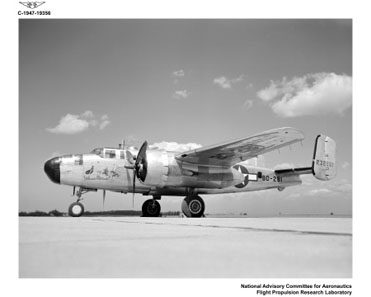XB-25E
History
As the war continued, the B-25 bomber was involved in worldwide operations. The limitations of the current inflatable leading edge de-icer boots were becoming apparent. It was believed necessary to develop a system that would improve the issue. A new facility, The Ice Research Base, was established to study ice and frost effects on aircraft and to develop effective solutions to the problems. The XB-25E was North American Aviation's test aircraft. Also included in this test program were a B-17F, two B-24s, an XC-53A, an A-26, a C-82 and a B-26.
The XB-25E was not produced, but rather modified from an existing B-25C-10-NA bomber. Modification began in early 1943 and continued through February of 1944. Extensive modifications were made inside the wing to allow for the movement of air heated by exhaust gases. The engine cowlings were modified to provide the air to be heated for the system. A heat exchanger was fitted to the exhaust and control valves were placed to control air flow. After minimal testing by North American, the aircraft was delivered to the Lewis Research Center at Cleveland, Ohio in July of 1944.
Over the next several years, the XB-25E (now known as "Flamin' Mamie") was involved in extensive testing. In February and March of 1945, the XB-25E was used to test the effect of icing on propellers. The airframe de-icing system was so effective that it was possible to isolate the effect of icing on just the propellers. Through the rest of 1945 and 1946, the XB-25E was used in testing to develop improved anti-icing systems for just about every part on the aircraft.
Testing with the XB-25E would continue until February of 1953 when she was returned to the United States Air Force as Wright Field. The result of the testing proved the effectiveness of the design, but the cost was prohibitive. The information gathered in testing also proved invaluable to improve the safety of future aircraft in icing conditions.
XB-25E Specs |
- Model: XB-25E
- Total Produced: 1 (modified from a B-25C-10-NA)
- Manufacturing Plant: Inglewood, California
- First Test Flight: February 4, 1944
- First Flight Crew: Pilot: Joe Barton
- Engines: Wright R-2600-13
- Carburetors: Holley 1685HA
- Fuel Capacity:
- 2 forward wing cells, total 368 gallons
- 2 rear wing cells, total 302 gallons
- 2 wing auxiliary cells, total 304 gallons
- 2 side waist ferry tanks, total 125 gallons
- Droppable bomb bay tank 335 gallons
- 1 fixed ferry tank 585 gallons
- Armament:
- None
- Armor Protection: 3/8 inch plate behind pilots and bombardier, under bombardier
- Weights:
- Empty: 20,300 lbs.
- Max: 34,000 lbs.
- Speed (Max): 284 mph at 15,000 feet
- Service Ceiling: 21,200 ft
- Range: 1,500 miles
- Crew:
- Pilot, co-pilot, engineers
- Production by year:
- 1944: 1
- First Airplane Accepted: N/A
- Last Airplane Accepted: N/A
| Model | NAA Contract | SN | NAA # | # Produced |
|---|---|---|---|---|
| XB-25E | N/A | 42-32281 | 94-12689 | 1 |
- NAA Contract:
- N/A
- Major Visual Production Block Changes:
- Single production block
- Notable Aircraft:







